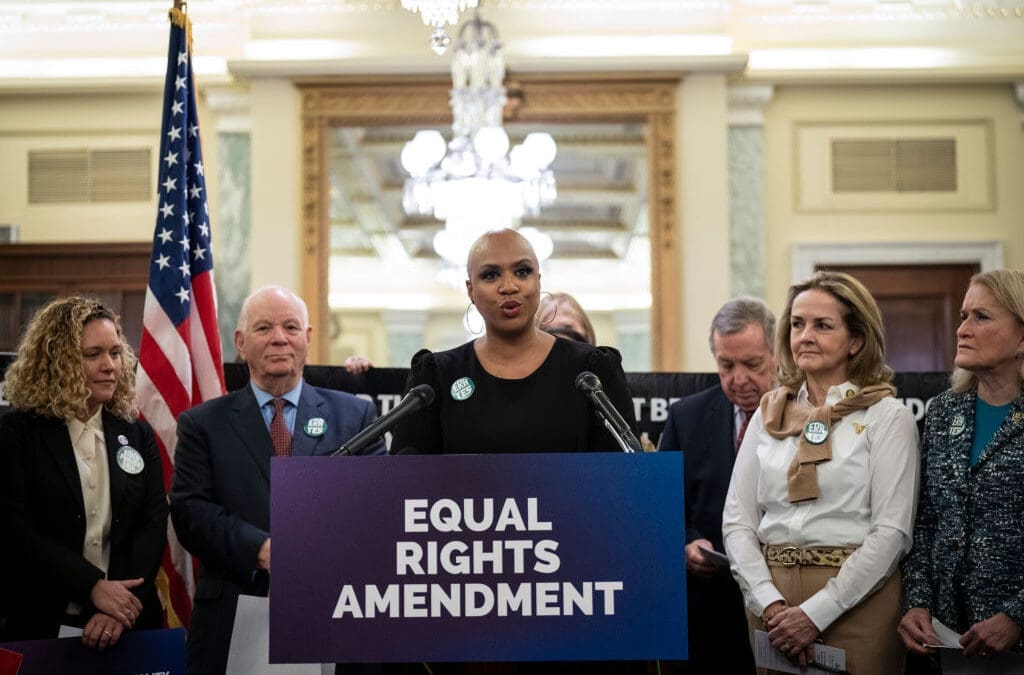
In Washington, an afternoon of solidarity for trans rights
April 1, 2025
Harvard and Princeton Are the Latest Ivies to Have Their Funding Targeted By Trump | Common Dreams
April 1, 2025Sen. Lisa Murkowski (R-Alaska), Rep. Ayanna Pressley (D-Mass.) and other colleagues are sponsoring a resolution affirming the ratification of the Equal Rights Amendment.
Rep. Ayanna Pressley (D-Mass.) introduced an Equal Rights Amendment (ERA) congressional resolution in commemoration of Equal Pay Day, March 25, to highlight economic gender discrimination and show why constitutional equality is needed now more than ever to close the income gap between women and men.
Economic issues are intrinsically linked to the ERA due to numerous federal policies that cannot be fully rectified at the state level. These include persistent gender disparities in wages and benefits, lifetime earnings, pink taxes, insurance rates, benefits for part-time work, retirement packages and the Social Security system.
Entitled Establishing the Ratification of the Equal Rights Amendment, the language of the ERA Joint Resolution in United States Senate (S.J. Res. 38) and in the House (H.J. Res. 80) is quite simple:
Resolved by the Senate and House of Representatives of the United States of American in Congress assembled, That notwithstanding any time limit contained in House Joint Resolution 208, 92nd Congress, as agreed to in the Senate on March 22, 1972, the article of amendment proposed to the States in that joint resolution is valid to all intents and purposes as part of the United States Constitution having been ratified by the legislatures of three-fourths of the several States.
This resolution was immediately referred to the Senate and House Judiciary Committees. Both are chaired by Republicans who oppose the ERA: Sen. Chuck Grassley (Iowa) and Rep. Jim Jordan (Ohio). However, both committees have strong Democratic ERA supporters, with the Ranking Democratic members Sen. Dick Durbin (Ill.) and Rep. Jamie Raskin (Md.).
ERA Resolutions: Yesterday and Today
The journey to the Equal Pay Day introduction of a joint congressional resolution helping to move the ERA forward has been long and complicated.
A version of an equality amendment to the Constitution was first introduced in 1923, soon after the 19th Amendment on women’s suffrage was ratified after a century of campaigns, political battles and arrests. For most of the past 100 years, both Republicans and Democrats came together to introduce and support the current Equal Rights Amendment, as ratified by the States and affirmed in a statement by President Biden as “the law of the land.”
The ERA finally was passed in the House of Representatives when savvy former Democratic members led by Martha Griffiths (D-Mich.) and Shirley Chisholm (D-N.Y.) devised a discharge petition strategy to break the decades-long logjam in the House Judiciary Committee. Republican Gerald Ford (R-Mich.), the House Minority Leader before becoming President, played a crucial role in securing Republican votes. In 1972, the House voted 354 to 24, and the Senate voted 84 to 8 in favor of the ERA and three sections passed by Congress to be included in the Constitution were promptly sent to the states for ratification.
Four decades later, the Virginia legislature ratified the ERA in 2020, fulfilling the crucial requirement of having the necessary three-fourths of the states ratify as spelled out in Article V of the Constitution. This milestone allowed for the ERA to be enshrined as the 28th Amendment to the Constitution.
Fast forward to Equal Pay Day 2025. The press release announcing the introduction of the ERA joint resolution in this Congressional session explains that “this resolution would eliminate an arbitrary deadline set by Congress in 1972, paving the way for the ERA to become the 28th Amendment of the Constitution of the United States, prohibiting discrimination on the basis of sex.”
When the resolution is passed, Congress, in its official role under Article V, will join in affirming ratification of the amendment and support President Biden’s position that the Equal Rights Amendment is the law of the land. Although Congressional action is not technically required, many believe that Congressional recognition of ERA ratification is an insurance policy guaranteeing that “equality of rights” cannot be “denied or abridged” in any future federal or state court actions.
Today’s ERA Champions and Lead Congressional Sponsors
The 2025 lead ERA sponsors in Congress, a majority of whom are women of color, include longtime, seasoned members, along with others who were recently elected and bring new voices of support.
On the Senate Side
Sen. Lisa Murkowski (R-Alaska) joined the United States Senate in 2002 after serving in the Alaska House of Representatives since 1999. She has garnered a reputation for a collaborative and bipartisan approach to policymaking. Since 2011, she has consistently co-sponsored this ERA resolution, demonstrating her unwavering support for advocates campaigning for additional state ratifications of the Equal Rights Amendment (ERA).
Murkowski has actively engaged in the fight for women’s equality by delivering regular floor speeches, appearing in the media and urging her party to reclaim its ERA leadership.
“The state of Alaska ratified the ERA and amended the State Constitution in 1972, and that is a legacy I am proud to continue advocating for at the federal level,” said Murkowski. “It is past time for the equal rights of women to be guaranteed in the United States Constitution, and I will continue to advocate for the passage of this resolution until that is achieved.”
This Congressional session, Murkowski is joined by Democratic Sen. Mazie Hirono of Hawaii. Hirono, who was first elected to the Senate in 2013 after serving six years in the House of Representatives. She is a strong advocate for human rights issues and sits on the all-important Senate Judiciary Committee. Hirono will take over as an ERA lead sponsor for the first time due to retirement of Maryland Sen. Ben Cardin in 2024.
“I am proud that Hawaii was the first state to ratify the ERA, but we must finally amend the Constitution to ensure that the next generation of women are guaranteed equal rights,” said Sen. Hirono. “With the reintroduction of this resolution, we reaffirm our commitment to fighting for equal opportunity and equal rights for all. It has been over a century-long fight to ratify the Equal Rights Amendment, and we won’t stop until gender equity is enshrined in the Constitution.”
On the House Side
Reps. Ayanna Pressley (Mass.-07), Madeleine Dean (Pa.-04), Sylvia Garcia (Texas-29), Sydney Kamlager-Dove (Calif.-37), and Jennifer McClellan (Va.-04) are collectively taking the lead on moving the ERA resolution, H.J. Res. 80, forward.
Representative Pressley describes her public servant career as fighting to ensure that those closest to the pain are closest to the power—driving and informing policymaking. Her views on the Equal Rights Amendment follow in this tradition.
“For centuries, women—particularly women of color and LGBTQ+ folks—have been treated as less than—less deserving of pay, less protected by law, less free to show up as our authentic selves in a world that constantly pushes us down,” said Pressley.
“By enshrining the ERA into law, we are taking the necessary step to center our most vulnerable and marginalized communities, close the gender wage gap, combat sex discrimination, reduce gender-based violence, ensure freedom over our bodies and more. The time is now to affirm gender equality once and for all.”
Representative Pressley was recruited in 2023 by the Democratic Women’s Caucus to lead the fight for the ERA after long-time supporters and lead-cosponsors Carolyn Maloney of New York, and Jackie Speier of California both left Congress.
As the lead Democratic sponsor in last year’s 118th Congress, Pressley filed a discharge petition in July 2023, on the ERA resolution following the same strategies used by Griffiths and Chisholm in 1971 to secure passage of the amendment. After an aggressive outreach campaign by ERA supporters, the discharge petition garnered 214 Democratic signatures by June 2024 but still needed four Republicans to reach the 218-vote threshold. The fall election results, Republican opposition and challenges in the Senate resulted in a pause by those working on the discharge petition and ERA joint resolution strategies in Congress.
This year, Pressley and other advocates are planning to rebuild and expand the Congressional Caucus on the Equal Rights Amendment, first launched in 2023. She also co-chairs the Reproductive Freedom Caucus and is an active progressive leader on a host of issues.
Pressley has recruited four others to join in the fight for the ERA, including those who have for many years been involved in the women’s rights movement and the ratification of the ERA.
ERA co-sponsor Rep. Sylvia Garcia from Texas, at age 27, was a delegate at the 1977 National Women’s Conference in Houston, and today she proudly wears the ERA pin given to those who attended. Two years ago, she joined thousands in Seneca Falls, N.Y. to commemorate the 175th anniversary of the first women’s rights convention of 1848 that developed the Declaration of Sentiments.
“I went to Seneca Falls and met with the next generation of activists. Let me tell you—they are just as committed, just as fearless, as I was back then. And like me, they’re still waiting for this country to guarantee women the same constitutional protections as men,” said Garcia. “Those fighting against the ERA are the same ones who fear powerful women—the ones who pay us less, promote us less, and try to silence us. It’s long overdue to make the ERA the 28th Amendment of the Constitution. I stand today for justice, for fairness, and for future generations of women and girls who deserve fairness, justice, and equality of opportunities.”
Soon after the introduction of House Joint Resolution 80, Garcia went to the House floor with a blown up photo of her at the Houston conference urging Congress to take action.
Rep. Jennifer McClellan of Virginia, another key co-sponsor, was a driving force in the Virginia State Senate that resulted in securing the 38th state needed to ratify the ERA. “I led the fight taking a stand on the right side of history,” she said. “Now we must finish the job by enshrining gender equality in the Constitution once and for all.”
“Generations of women, especially women of color, have relentlessly fought for equal rights in a system that has long denied them fairness under the law—and that fight is far from over.” McClellan’s leadership in Virginia is featured in the documentary RATIFIED and is an inspiration to supporters in workshops, conferences and theaters across the United States.
This Congressional session, Rep. Sydney Kamlager-Dove (Calif.) secured a seat on the House Judiciary Committee which is where the ERA has been referred for future action. She stands firm that there is no deadline for equal rights. Elected to the House in 2022 after having served as a member of the California State Assembly and later in the State Senate, Kamlager-Dove is outspoken about the ERA: “The United States Congress and the required number of states have ratified the Equal Rights Amendment, which is over 100 years in the making. An arbitrary deadline will not stop progress on equal rights. Now is the time for Congress to pass this resolution to ensure that we enshrine equal protections for our mothers, sisters, daughters, and grandmothers who have championed this cause.”
Rep. Madeleine Dean’s concern for equality eventually inspired her run for Congress. In 2018, Pennsylvania had 18 Congressional seats—and zero women representing them. Along with a cadre of other women from across the state, Dean set out to change that. She ran for the Fourth Congressional District seat and won.
She has learned many political lessons and tells supporters, “Words matter—and we must be explicit in our Constitution to ensure that equality is a reality for every person in our nation. We must expand the mission of the 19th Amendment and fulfill the promise of the ERA. The Equal Rights Amendment is a short yet powerful declaration—‘Equality of rights under the law shall not be denied or abridged by the United States or by any state on account of sex.’”
The national ERA Coalition, on behalf of its more than 300 members, gave a shout to the cosponsors, “We are grateful for the leadership of Sen. Lisa Murkowski, Sen. Mazie Hirono, and Rep. Ayanna Pressley in reintroducing this important resolution, recognizing the ratification of the Equal Rights Amendment…we renew our commitment to the pursuit of true gender equality. The women who came before us didn’t give up, neither will we.”
Upon introduction of the House Joint Resolution 80, 124 Democratic members signed on as co-sponsors before introduction, joined by one Republican, Mike Lawler from New York.
ERA supporters will recruit more House members as cosponsors. “To show continued support, our goal is to have all of the Democrats who were on last year’s discharge petition on as co-sponsors and all of the newly elected ones,” says Mary Ann Gorman, a team member of Sign4ERA petition drive. “Then we can seek out Republicans who support equality and will stand up for all people as the GOP did when the ERA was first introduced in 1923 and when it passed in 1972,” she added.
All Three Sections: More Important than Ever
Since the ERA was introduced, most references are focused just on Section One. However, the combination of Section One and Section Two will work together to end sex discrimination and to protect the hard-fought rights won over the last 50 years.
Section One: Equality of rights under the law shall not be denied or abridged by the United States or by any state on account of sex.
Section Two: The Congress shall have the power to enforce, by appropriate legislation, the provisions of this article.
The third section, also ratified by the states, sets a time limit for when the ERA takes full effect:
Section Three: This amendment shall take effect two years after the date of ratification.
The ERA as the 28th Amendment is a guarantee that Congress can pass laws prohibiting sex discrimination without judicial challenges of their authority to do so. The late Supreme Court Justice Antonin Scalia raised this issue in 2011 when he was widely quoted as claiming that the equal protection clause of the 14th Amendment to the Constitution does not protect against discrimination on the basis of sex. His statement claims that women are not part of the Constitution, a notion supported by at least two of the current Supreme Court judges in recent decisions.
Since the Dobbs decision on abortion, extremist judges on the Supreme Court and lower federal courts have been setting the stage for reversing laws and policies that have helped to end gender discrimination.
“Only the ERA will ensure permanent, nationwide protection for a wide range of personal freedoms ranging from abortion and birth control to marriage rights, financial equality, access to equal legal protection against sexual violence, and a host of other basic rights,” said Ellie Smeal, President of the Feminist Majority and an ERA leader since 1972 when it first passed in Congress. “The ERA provides guardrails and a safety net to prevent Dobbs from becoming a springboard to other issues and a guarantee that Congress can pass laws, including restoring abortion rights, affirmative action and laws on sexual assault, that will work to end sex discrimination.”
The confluence of extremist threats to abortion and reproductive health care, coupled with a long-standing demand for gender equality, has resulted in a supermajority of voters—over 75 percent in recent polls—demanding that the permanent protections of the ERA now be affirmed and enshrined in the Constitution as the 28th Amendment.
A Petition Drive to Enshrine the ERA into the Constitution
When Rep. Carolyn Maloney left Congress in 2023, her biggest disappointment was the lack of progress on the Equal Rights Amendment. As a passionate advocate, she was a lead ERA cosponsor in the House since being elected in 1993. After the Virginia ERA ratification, a joint resolution like the one being circulated today passed in the House in 2021, only for it to be stalled in the Senate.

Since leaving Congress, Maloney had struggled to find a way to mobilize public support with easy action steps. As the Eleanor Roosevelt Distinguished Leader in Residence at Hunter College’s Roosevelt House Public Policy Institute, she worked with her students to brainstorm class projects on the ERA. They decided to start a national ERA petition drive after researching other successful petitions, visiting the National Archives, and learning that the right to petition is enumerated in the First Amendment to the Constitution, which specifically allows the right “to petition the Government for a redress of grievances.”
Sign4ERA was launched in April 2023 at an event with students and women’s rights leaders. Then Senate Majority Leader Chuck Schumer gave a passionate speech in favor of the ERA, holding up a photo of his new granddaughter as he stepped forward to be the first person to sign the petition.
The following week, Schumer called a vote on the ERA resolution in the Senate that won by a majority of 52 votes, but fell short of the 60 votes to stop a filibuster. At that time, Democratic leadership left open the opportunity for another floor vote during that current (118th Congressional) session if the ERA passed the House first.
The Sign4ERA petition drive went into in full swing with ERA champions regularly meeting to plot strategies, share ideas and collect more and more signatures. Throughout the last two years, Maloney served as a volunteer for the ERA from her Hunter College office and as the elected President of New York State NOW, the National Organization for Women. She made countless phone calls, gave speeches, attended dozens of meetings and commuted back and forth to Washington.
“By 2024, we were closer than ever before to successfully passing the Congressional joint resolution using a discharge petition strategy,” Maloney told supporters. “We only needed a handful of Republicans in the House. Today, with the right strategies in place, I believe we can convince them, provided we remain steadfastly focused on mobilizing our supporters and expanding the Sign4ERA petition in key states, cities and towns,” Maloney added.
Over 125,000 people have joined the Sign4ERA petition in a relatively short period. Maloney hopes to reach one million people by the next election cycle. This all-volunteer effort is based on harnessing the expertise of a passionate team of volunteers of all generations and a crew of unpaid seasoned veteran strategists, academic experts, grassroots organizers, data analysts and media specialists.
With the White House and Congress controlled by a Republican Party that officially opposes the ERA, the next four years will be an uphill battle. Supporters feel they need to be ready should unpredictable events create more open Senate or House seats due to resignations, scandals or deaths.
Maloney is related to Alice Paul through her marriage to one of her family members. “Aunt Alice never gave up and neither will we,” Maloney told supporters in one of her speeches. Paul wrote the 1923 Equal Rights Amendment, made sure it got introduced over the next 50 years and lobbied its 1972 passage in Congress. “Now it’s time that we secure Constitutional rights to move forward and not let any rouge judge or any federal or state court bulldoze over our hard-fought rights,” Maloney said. “I keep reminding myself that It’s Impossible, until it’s done.”
A note to Ms. readers: You can help enshrine the ERA into the Constitution by going to www.sign4ERA.org and signing the ERA petition yourself and asking other family and friends to do the same. Sign4ERA has been endorsed by more than 40 women’s rights organizations, including the ERA Coalition; civil rights and human rights groups; and scores of mayors, governors, campus organizations and religious and civic groups.
Great Job Kathy Bonk & the Team @ Ms. Magazine Source link for sharing this story.






